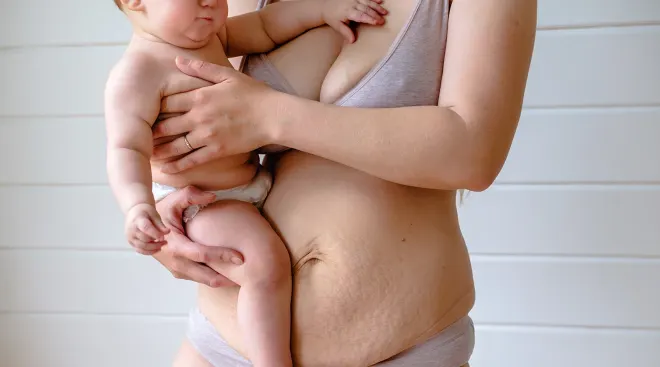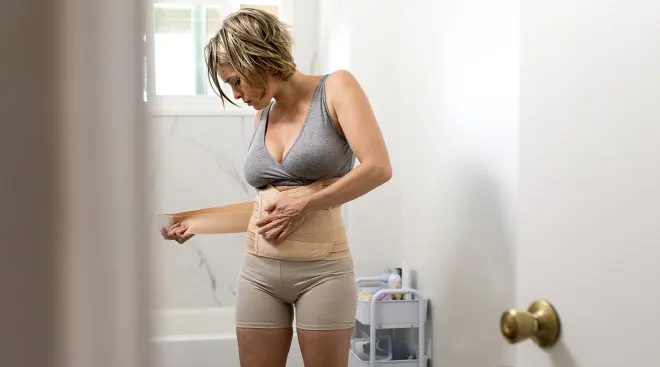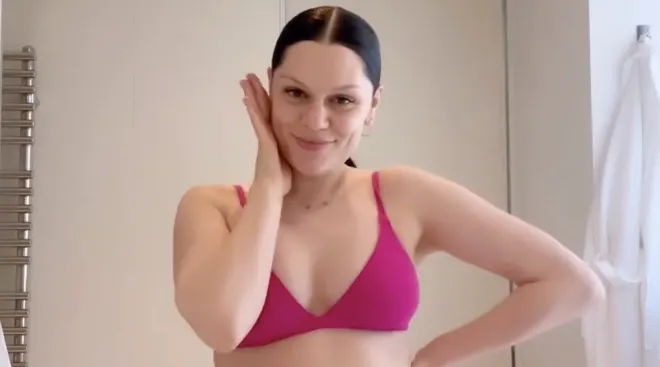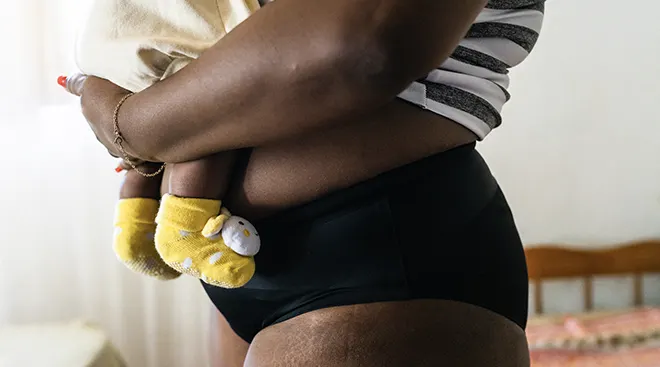Can You Get Rid of Stretch Marks After Pregnancy?
Pregnancy changes your body in many ways, and while all of those changes are a natural and beautiful part of your journey to baby, they can still feel jarring. One example? Postpartum stretch marks. These usually start popping up during pregnancy (mostly as your bump grows), but they can take some time—up to a year—to heal. While it can be hard to adjust, know that those stretch marks are a sign of the incredible accomplishment your body just pulled off and are nothing to be ashamed of. Still, if you’re struggling with their appearance and wondering how to get rid of your stretch marks after pregnancy, keep reading. We asked ob-gyns and dermatologists for the lowdown on dealing with stretch marks after pregnancy, from why they happen to what you can do to treat them.
Stretch marks are scars that develop when skin expands or shrinks rapidly, resulting in small tears to the collagen and elastin within the skin, according to the American Academy of Dermatology Association (AAD). Stretch marks can appear as pink, purple, reddish or brown streaks across the skin. Most women—up to 90 percent—will get pregnancy stretch marks on their abdomen, butt, hips, upper thighs and/or breasts towards their second or third trimesters. But genetic factors do influence whether or not you’ll get them. (Learn more about the factors that affect stretch marks here.)
While they’re incredibly common during pregnancy, you may also notice the appearance of stretch marks postpartum. “Stretch marks can show up on your breasts when your milk comes in,” says Rebekah Mustaleski, CPM, a certified professional midwife and compression director at Motif Medical. “That skin stretches to accommodate your enlarged milk ducts, which can sometimes create stretch marks on the sides and front of the breast.”
You may also get stretch marks after pregnancy due to natural hormonal changes and those caused by birth control (which your ob-gyn will likely recommend going on to avoid another pregnancy so soon after birth), adds Cynthia Flynn, MD, a Florida-based ob-gyn with JustAnswer.
Dealing with itchy stretch marks after pregnancy
Stretch marks can itch as they heal, Mustaleski says, but any discomfort should be mild. If you’re experiencing severe itchiness with postpartum stretch marks or get a rash on your body, flag it to your ob-gyn. While it rarely pops up postpartum, any severe itching could be a sign of a PUPPP rash.
Do stretch marks go away after pregnancy?
Stretch marks are scars on your skin, the AAD says, which means they’re permanent. However, most people find that their postpartum stretch marks do fade and become less noticeable over time. “It takes about a year after pregnancy to get an idea of what they’ll look like moving forward,” Flynn says.
Wondering how to get rid of stretch marks after pregnancy? While postpartum stretch marks are permanent, “the appearance of stretch marks can be improved and blended to the surrounding skin,” says Jennifer MacGregor, MD, a dermatologist in New York City. Below, some methods that may help minimize the appearance of postpartum stretch marks. Keep in mind, though, that there are no scientifically proven ways to completely get rid of stretch marks after pregnancy.
Moisturize your skin
There are lots of stretch mark creams designed to help get rid of stretch marks after pregnancy—but be wary of these claims, Mustaleski says, as there’s no scientific evidence that these stretch mark creams work. That said, keeping your skin moisturized is a great way to boost its elasticity and overall health. While a moisturizer can’t prevent or get rid of them, it may help to lighten stretch marks after pregnancy. The AAD recommends using the moisturizer daily for weeks, as results may take a while to appear, as well as massaging the product into the stretch marks thoroughly to make it more effective. Moisturizing stretch marks can also help alleviate any itching as they heal. Resist the urge to scratch, says Christine Greves, MD, an ob-gyn in Orlando, Florida, as scratching could lead to further scarring.
If you’re looking to treat postpartum stretch marks naturally, you might come across suggestions to use lemon juice, castor oil, egg whites or aloe vera as topical moisturizers. However, none of these are guaranteed to work. “People think they work [because stretch marks] become less visible and prominent on their own,” says Gerald Imber, MD, a plastic surgeon in New York City and the founder of the Youth Corridor Clinic—but that’s just stretch marks naturally fading over time.
Instead, both the AAD and Flynn recommend using topical creams with hyaluronic acid and tretinoin. Previous studies have noted that creams with hyaluronic acid may help boost skin collagen production. Plus, a 2016 study found that topical application of tretinoin, a retinoid, may help improve the appearance of early stretch marks. “Retinoids may slightly improve striae alba (those white shiny stretch marks) by building collagen and thickening the skin, but most topical treatments do not,” MacGregor says. “Laser is the best option.” (More on this below.) It’s worth noting that as a retinoid, tretinoin usually isn’t safe for use in pregnancy or while breastfeeding. Remember to always speak with your ob-gyn before using any topical creams for pregnancy and postpartum stretch marks.
Laser therapy for postpartum stretch marks
There are a number of cosmetic procedures dermatologists can do to help minimize the appearance of stretch marks after pregnancy, including chemical peels, microdermabrasion (a non-invasive treatment that exfoliates the skin) and laser therapy. Your dermatologist may use multiple methods to get the best results, the AAD says, and some may have minor side effects, such as redness and swelling. But according to all the experts we spoke with, laser therapy is considered one of the most effective treatments for the removal of postpartum stretch marks—and there’s a good reason why. According to the American Society for Dermatological Surgery, laser therapy uses light to reach deep into the skin’s sublayers to repair and regenerate skin cells. It promotes collagen production to rebuild damaged tissue, resulting in smoother skin with improved texture and color. While laser therapy may not make them go away completely, it can considerably lighten stretch marks after pregnancy.
Microneedling for postpartum stretch marks
Though effective, MacGregor and Imber don’t recommend relying solely on laser therapy treatment. Instead, they suggest combining it with microneedling (a practice that’s similar to microdermabrasion). According to Yale Medicine, microneedling uses small needles to puncture the skin with the aim of stimulating skin repair and collagen production (similar to laser therapy). When combined with fractional resurfacing lasers (a form of laser light therapy), microneedling can “build collagen and improve the texture of skin, making it a little thicker,” MacGregor says. “Stretch marks will never resolve /[completely], but they will be less noticeable if the color and texture are blended to look more similar to the surrounding skin.”
In his practice, Imber also combines microneedling with platelet-rich plasma (PRP). “PRP is a high concentration of cellular elements from your own blood that promote cell growth, tissue repair and collagen production,” he explains. “When PRP is used for scar reduction, your growth factors and stem cells work together to strengthen skin cells deep under the superficial layer of skin. The treatment targets skin laxity, hyperpigmentation and overall skin tone and texture.” Essentially, this means PRP works to improve skin color, texture and tautness.
The bottom line? It may a take a while but stretch marks do fade over time—even years later, Flynn says. However, if you’re unhappy with your appearance and would like a more permanent solution, consult with a dermatologist about laser therapy, microneedling and other cosmetic treatment options that could be right for you.
Unfortunately, until recently, society has largely viewed postpartum stretch marks as something to “minimize” or “prevent.” But the reality is that they’re a largely unpreventable—and beautiful—part of pregnancy. Stretch marks after pregnancy are proof of the amazing feat your body just accomplished. Rather than something to hide, postpartum stretch marks are something to own, be proud of and celebrate. Luckily, thanks to celebrities, the conversation around postpartum stretch marks has begun to shift in recent years. More women are posting pictures of their unedited stretch marks after pregnancy on social media and reminding their audiences that stretch marks are a natural part of the pregnancy journey. Below, some of the people who are helping change the conversation:
Ashley Graham
Ashley Graham has been a body-positivity advocate for years—and pregnancy was no different. The supermodel gave birth to her first son back in 2020 and welcomed twin boys in 2022. Scroll through Graham’s Instagram account and you’ll see several photos in which she not only embraces her stretch marks after pregnancy, but encourages her followers to do the same.
Halsey
The singer welcomed her son in 2021—but she started celebrating pregnant bodies long before giving birth. Not only did her 2021 album cover pay homage to motherhood, but in the weeks following her son’s birth she also opened up about feeling like a stranger in her postpartum body, as well as shared a candid photo of her stretch marks after pregnancy.
Emily Skye
The personal trainer gave birth in 2017 and proudly posted an unedited version of her postpartum body in the weeks that followed. “Saggy, wrinkly belly skin, sometimes you can see it and other times you can’t,” Skyes wrote at the time. “I’m proud of what it represents…I grew a human in this belly and the whole process into motherhood has made me SO much stronger and also so much more confident in myself and my body…Nobody is perfect and having some extra skin, stretch marks, cellulite or whatever else doesn’t make you any less beautiful or amazing!”
Teigen posted this unedited clip of her stretch marks and developing “mom bod” back in 2018. In the years since, the cookbook author has remained unflinchingly honest about the challenges and joys of pregnancy and motherhood—and not just the physical changes it brings, but the emotional ones as well.
Robyn Lawley
The Sports Illustrated model first posted about her stretch marks after pregnancy back in 2016, after welcoming her daughter the year prior. She wrote about being immensely proud of her body: “They are some bad*ss tiger stripes. And I earned them,” she wrote in her caption. “We put an unbelievable amount of ridiculous time consuming pressure on women to care so much about their flaws they forget how truly beautiful they (you) are today. And to anyone who feels bad about your body especially after a baby, you are a warrior, you created a life inside of you, that’s no easy feat.”
About the experts:
Cynthia Flynn, MD, is a board-certified ob-gyn based in Florida with over 20 years of experience. She is also an expert with the online platform JustAnswer. She received her degree from the Michigan State University College of Human Medicine.
Rebekah Mustaleski, CPM-TN, IBCLC, is a certified professional midwife specializing in evidence-based maternity care. She co-founded Roots & Wings Midwifery in Knoxville, Tennessee. Mustaleski received her bachelor’s degree in psychology from Centre College and worked as a doula and birth photographer prior to establishing Roots & Wings.
Christine Greves, MD, is an ob-gyn at the Winnie Palmer Hospital for Women & Babies in Orlando, Florida. She received her medical degree from the University of South Florida.
Gerald Imber, MD, is a plastic surgeon in New York City and the founder of the Youth Corridor Clinic and author of the best-selling book The Youth Corridor. He also serves as an attending plastic surgeon at New York-Presbyterian Hospital, as well as an assistant clinical professor at the Weill-Cornell Medical Center. He earned his medical degree from the State University of New York Medical College and completed his plastic surgery training at the New York Hospital Cornell Medical College.
Jennifer MacGregor, MD, is a board-certified dermatologist in New York City and an assistant clinical professor of dermatology at the Columbia University Medical Center. She received her medical degree from Georgetown University School of Medicine and completed her dermatology residency at Columbia University Medical Center in New York City. She completed her laser, cosmetic and dermatologic surgery fellowship at SkinCare Physicians in Boston.
Please note: The Bump and the materials and information it contains are not intended to, and do not constitute, medical or other health advice or diagnosis and should not be used as such. You should always consult with a qualified physician or health professional about your specific circumstances.
Plus, more from The Bump:
Navigate forward to interact with the calendar and select a date. Press the question mark key to get the keyboard shortcuts for changing dates.




















































